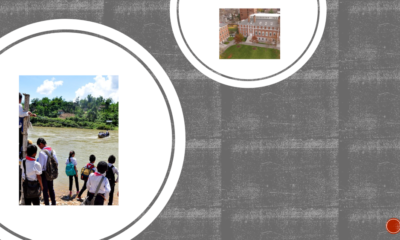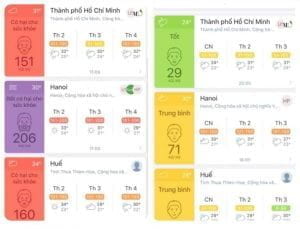Thuy Nguyen
Download pdf
Abstract
This essay examines the growing concerns surrounding environmental management and the regulation of information in Vietnam, focusing on the case of air quality monitoring in Hanoi and Ho Chi Minh City. It explores the rising public awareness of severe air pollution, driven by real-time data from the AirVisual app, which revealed alarming pollution levels exceeding national and international standards. As the public’s concern grew, the Vietnamese government responded by increasing monitoring efforts but simultaneously attempted to suppress the app’s access within the country, reflecting broader patterns of control over information. The paper discusses the role of government censorship, particularly through the use of cyber-troops and the manipulation of online platforms, to maintain a monopoly on public discourse.
Keywords: Vietnam, environment, information management, air quality
The Case of Air Quality Index
There are deep and growing concerns about the management of public resources in Vietnam, particularly with regard to critical elements such as air, water, and forests.[i] These resources are essential to the country’s environmental health and the well-being of its citizens, yet their management has become increasingly controversial. Citizens, environmental activists, and international observers have raised alarms about the government’s handling of these issues and the long-term consequences for both the environment and public health.
In recent years, residents of the metropolitan areas of Hanoi and Ho Chi Minh City – the two largest cities, housing a quarter of the nation’s population – have experienced severe air pollution. Public concern reached its peak last week when AirVisual, an environmental monitoring application providing real-time air quality data, revealed the alarming levels of pollution in these cities. The Air Quality Index (AQI) frequently indicated red (unhealthy) or purple (very unhealthy) levels, with Hanoi and Ho Chi Minh City consistently ranking among the worst globally. At times, PM2.5 levels exceeded Vietnam’s national standard by elevenfold, and were twenty-five times higher than the World Health Organization’s (WHO) recommended limit.[ii]
As this information spread, public awareness of the hazardous effects of toxic air increased. Social media platforms were flooded with posts, comments, and shares, as citizens began to question the Vietnamese government’s response to the mounting public health crisis. Discussions ranged widely, from comparisons with citizens in Indonesia who had taken legal action against their government for air pollution, to Thailand’s government efforts to address similar environmental issues.
Prime Minister Nguyen Xuan Phuc directed the leaders of Hanoi and Ho Chi Minh City to address the air pollution crisis. Later that day, the Vice Minister of Environment and Natural Resources announced plans to install additional monitoring stations to improve public access to information.[iii]
However, soon after, AirVisual, which had been among the most downloaded apps in Vietnam in recent weeks, became inaccessible for IP addresses within the country. Users who managed to access the app through international IPs (using VPNs or similar methods) could still download it. For those who already had the app installed, updates were still available, but only with data provided by the Vietnamese government, excluding information from independent monitoring stations like those of the U.S. Embassy in Hanoi.
Despite its value in raising awareness, AirVisual faced a wave of one-star reviews. Numerous individuals appeared to coordinate efforts to damage the app’s reputation commercially. Online communities identified a specific post believed to have incited the negative ratings. The post stated:
“I don’t know if the owners of AirVisual understand Vietnamese or not, but they must be pleased to see the foolishness of Vietnamese people these days—1.3 million downloads, around 10,000 page likes (some pages received 13,000 likes). And face masks are completely sold out. Our task now is to show them that ‘Vietnamese may be a bit silly but not obedient.’ Here’s what we can do:
- Report the fan page, give it a 1-star rating to bring it down.
- Uninstall the app, and report it.
- Pressure them to apologize.
Additionally, all newspapers that published articles titled ‘Hanoi was the most polluted in the world’ must be reported and forced to issue public apologies.”
After the app was blocked, air quality indicators for Hanoi and Ho Chi Minh City turned yellow, and occasionally green, suggesting that pollution levels were less severe.
Monopoly of Information
Vietnam remains steadfast in its control over the flow of information, implementing an extensive, systematic approach to managing and suppressing dissent online. In a 2013 address, the head of the Communist Party’s Propaganda Department in Hanoi disclosed that the city had mobilized approximately 900 online commentators, often referred to as “public opinion shapers” or “cyber-troops,” tasked with monitoring the internet for what the state considers “hostile information.” These cyber-troops actively engage in online discussions to defend the party’s stance, drown out critical voices, and promote government-approved narratives. Recently, these numbers are believed to have grown significantly, reflecting the increasing prioritization of digital control within Vietnam’s information strategy.
As of 2019, Vietnam had 859 print and 135 online newspapers and magazines, as well as 67 radio and television stations, all tightly controlled by the Central Propaganda Department of the Communist Party.[iv] As of 2019, Vietnam maintained a highly centralized and controlled media landscape, consisting of 859 print and 135 online newspapers and magazines, along with 67 radio and television stations. All of these media outlets operate under the strict oversight of the Central Propaganda Department of the Communist Party, which serves as the ultimate authority in shaping and disseminating information across the country. This centralization of media control is a strategic tool for the Vietnamese government, ensuring that all public narratives align with the party’s political goals and ideological framework.[v]
The Central Propaganda Department is responsible for reviewing, censoring, and approving all content before it is published or broadcasted. This control mechanism allows the government to filter information, eliminate dissenting views, and promote stories that enhance the image of the Communist Party while downplaying or completely ignoring issues that may provoke public criticism or unrest. Journalists and editors working within these outlets are expected to adhere to strict guidelines, often issued directly by the Propaganda Department, that dictate how to cover sensitive topics such as corruption, economic difficulties, or international relations, particularly concerning China and the United States.
This strict regulation extends to online media as well. Although the internet has provided a new platform for information dissemination, the Vietnamese government has ensured that online newspapers and magazines fall under the same stringent control as traditional print media. The state employs various tools, including content filters, internet firewalls, and cyber-policing measures, to monitor and regulate online content. News websites and blogs are routinely scanned for “anti-state” or “reactionary” content, and those deemed to be in violation are quickly censored, blocked, or taken down. Moreover, journalists and bloggers who attempt to publish critical or independent content online face severe repercussions, including intimidation, arrest, or imprisonment.
Recently, Vietnam has intensified its efforts to consolidate its propaganda and censorship mechanisms targeting the online community. This was evidenced by the establishment of the Cyber War Command (Bộ Tư lệnh Tác chiến Không gian mạng) under the Ministry of Public Security in 2017. These operatives, part of an organized system often called Force 47 (Lực lượng 47), are not merely passive observers but active participants who are trained to counter and suppress dissent.[vi] They monitor social media platforms, news websites, and independent blogs, identifying posts or comments deemed critical of the state or the Communist Party. Once flagged, these posts are reported, and the authors may be targeted with harassment, intimidation, or even arrest under the guise of combating “anti-state” propaganda.
Conclusion
All in all, the Vietnamese government’s efforts to regulate information and control the digital space highlight the lengths to which authoritarian regimes will go to maintain their monopoly on power. The rise of an increasingly informed and digitally connected population poses a direct challenge to traditional modes of censorship and propaganda.
The deployment of cyber-troops, the monitoring and suppression of independent voices, and the manipulation of digital platforms through disinformation campaigns all illustrate the state’s commitment to maintaining its authority in an age where information flows freely and rapidly. The establishment of specialized units, like Force 47 and the Cyber War Command, underscores the government’s recognition of the internet not only as a tool for public communication but also as a battleground for ideological control.
However, this intensified competition over cyberspace is a double-edged sword. While Vietnam has succeeded in temporarily silencing dissent and promoting its narratives, the very nature of the digital space—its openness, reach, and accessibility—continues to provide avenues for information to circumvent state control. Activists, independent journalists, and citizens, empowered by technology, find ways to challenge the government’s narrative, document human rights abuses, and call for transparency and accountability.
The government’s tightening grip on information may yield short-term successes in controlling public discourse, but it also risks deepening public distrust and dissatisfaction. The suppression of environmental data, as seen in the AirVisual incident, reveals a fragile strategy that prioritizes control over genuine solutions, often at the expense of public health and safety. As the gap between state narratives and citizens’ lived realities grows, the long-term sustainability of Vietnam’s information monopoly remains uncertain.
Reference:
[i] Nguyen, T., Tran, H., Nguyen, A., & Van, T. (2016). Community participation in rural water supply: a case study in My Hoa–Tra Vinh. Journal of Science and Technology, 54(4B), 178-184.
[ii] Hanoi Air Quality Index (AQI) and Vietnam Air Pollution | IQAir. (2024, October 11). Iqair.com. https://www.iqair.com/us/vietnam/hanoi
[iii] Hoai, T. (2019, October 3). PM Phuc wants Hanoi, HCMC to do more to tackle air pollution. VnExpress International – Latest News, Business, Travel and Analysis from Vietnam; VnExpress International. https://e.vnexpress.net/news/news/pm-phuc-wants-hanoi-hcmc-to-do-more-to-tackle-air-pollution-3991000.html
[iv] kayleedolen. (2020, July 19). Freedom of the Press under Renewed Siege in Vietnam – The 88 Project. The 88 Project. https://the88project.org/freedom-of-the-press-under-renewed-siege-in-vietnam/
[v] Vietnam. (2024, June 7). Rsf.org. https://rsf.org/en/country/vietnam
[vi] HOA, M. (2017, December 25). Hơn 10.000 người trong “Lực lượng 47” đấu tranh trên mạng. TUOI TRE ONLINE; tuoitre.vn. https://tuoitre.vn/hon-10-000-nguoi-trong-luc-luong-47-dau-tranh-tren-mang-20171225150602912.htm

 Politics & Economy4 years ago
Politics & Economy4 years ago
 Society & Culture5 years ago
Society & Culture5 years ago
 ARCHIVES5 years ago
ARCHIVES5 years ago
 Politics & Economy4 years ago
Politics & Economy4 years ago
 Politics & Economy1 year ago
Politics & Economy1 year ago
 Politics & Economy5 years ago
Politics & Economy5 years ago
 After 19751 year ago
After 19751 year ago
 Politics & Economy4 years ago
Politics & Economy4 years ago






